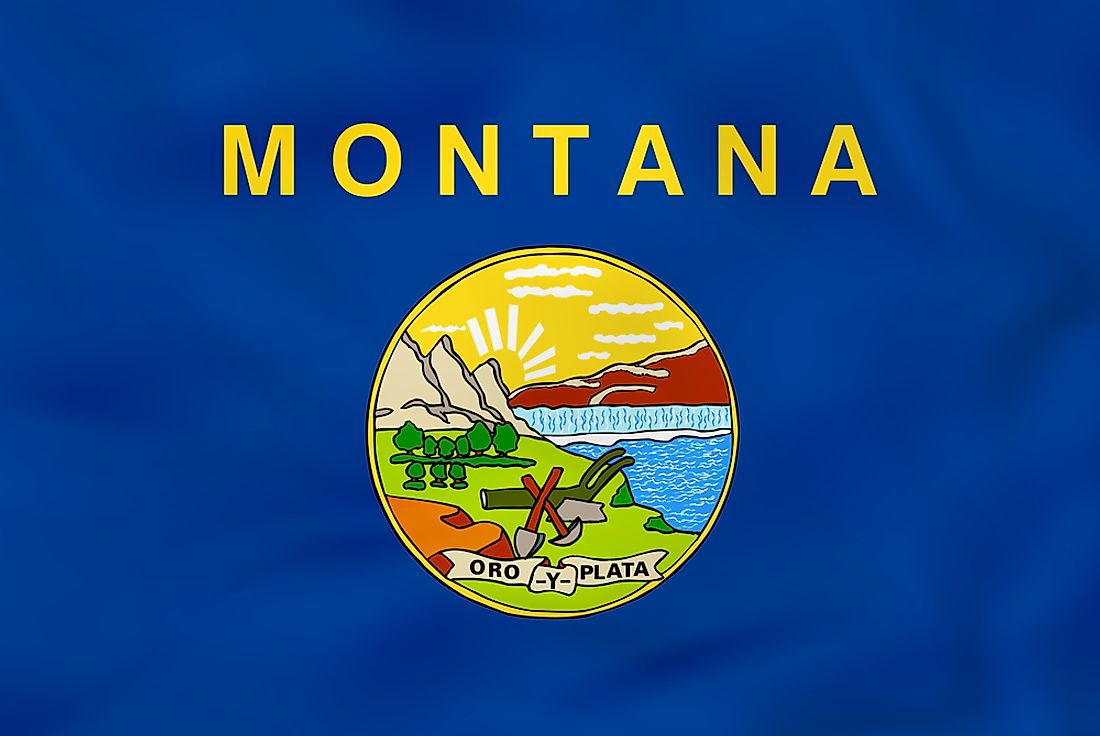Montana State Flag

The Flag of the state of Montana can be easily spotted by the bold word “Montana” in the middle of the blue flag. The seal of the state, strategically placed in the middle of flag, recognizes some of the prominent features of the state and pioneer economic activities of the citizens such as mining and agriculture. It also celebrates the green vegetation, water bodies and the history of the state. The motto of the state is placed below the seal acknowledging the vast mineral and metals such as gold, silver, copper, lead, manganese, and coal.
Design and Features of the Flag
The State flag was designed by Colonel Harry C Kessler. The flag consist of a blue background and the state seal in the middle. The dimension is in the ratio of 3:2 in length and width. The seal displays a rising sun with rays indicating a bright new dawn. The river and waterfalls portray a source of life while the mountains, cliffs, and hills depict the natural resources of the State. Farm equipment, among them a shovel and plow, are displayed on the foreground, symbolizing the agricultural and mining activities of the residents of Montana.
The flag has a blue field which symbolizes mindfulness, justice, courage, surveillance, and endurance. The yellow color on the seal signifies gold that was discovered in the state. The yellow color also symbolizes the warmth, wealth and the generous citizens. To maintain consistency when making flags, the state adopted “Helvetica bold” as the standard font for the name of the state on the flag.
The overall design of the flag is a pride of the state, showing off the mountains, forests, Missouri River, and cliffs. The state motto on a ribbon below the pick and shovel states "ORO Y PLATA" meaning the land of gold and silver.
History of the Flag
In 1898, Colonel Kessler led the military in the battle against Spain. The recruits were to carry a fine 45-star US flag. However, Colonel Kessler observed that the State forces needed a certain banner to identify them from other military contingents. He, therefore, crafted a simple dark silk flag measuring 44 by 60 inches with the state seal hand sewn on it.
When the army returned in October 1899, the flag, which was now highly accepted, was considered as the unofficial identification flag. Later when it was handed to the governor, it was put on display across the state. This initial attempt was applauded by many, eventually making the ninth legislative assembly to initiate a project to design a flag. In 1905, the first flag was adopted. The name "Montana" was added to the flag in 1981.
Uses of the Flag
The law gives the Montana State the permission to display the flag from sunrise to sunset on a flag post in any place and manner within the law. It can be flown at night if well lighted. As a show of loyalty to the state, an individual can display the flag on his car. It can fly half-mast in times of mourning a prominent person or to commemorate occasions the state might view as disastrous. Nevertheless, the flag is lowly rated by North American Vexillological Association (NAVA) at position 70 scoring only 3.0 on a scale of zero to ten.











